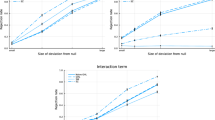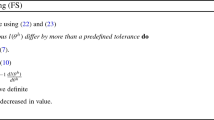Abstract
Mechanistic modeling greatly benefits from automated pre- and post-processing of model code and modeling results. While S-ADAPT provides many state-of-the-art parametric population estimation methods, its pre- and post-processing capabilities are limited. Our objective was to develop a fully automated, open-source pre- and post-processor for nonlinear mixed-effects modeling in S-ADAPT. We developed a new translator tool (SADAPT-TRAN) based on Perl scripts. These scripts (a) automatically translate the core model components into robust Fortran code, (b) perform extensive mutual error checks across all input files and the raw dataset, (c) extend the options of the Monte Carlo Parametric Expectation Maximization (MC-PEM) algorithm, and (d) improve the numerical robustness of the model code. The post-processing scripts automatically summarize the results of one or multiple models as tables and, by generating problem specific R scripts, provide an extended series of standard and covariate-stratified diagnostic plots. The SADAPT-TRAN package substantially improved the efficiency to specify, debug, and evaluate models and enhanced the flexibility of using the MC-PEM algorithm for parallelized estimation in S-ADAPT. The parameter variability model can take any combination of normally, log-normally, or logistically distributed parameters and the SADAPT-TRAN package can automatically generate the Fortran code required to specify between occasion variability. Extended estimation features are available to avoid local minima, estimate means with negligible variances, and estimate variances for fixed means. The SADAPT-TRAN package significantly facilitated model development in S-ADAPT, reduced model specification errors, and provided useful error messages for beginner and advanced users. This benefit was greatest for complex mechanistic models.







Similar content being viewed by others
Notes
The SADAPT-TRAN software is freely available via http://bmsr.usc.edu/.
References
Beal SL, Sheiner LB, Boeckmann AJ, Bauer RJ. NONMEM user’s guides (1989–2009). Ellicott City: Icon Development Solutions; 2009.
Lavielle M. Monolix (Version 3.1)—A free software for the analysis of nonlinear mixed effects models. The Monolix Group. Paris; 2009.
Lunn DJ, Best N, Thomas A, Wakefield J, Spiegelhalter D. Bayesian analysis of population PK/PD models: general concepts and software. J Pharmacokinet Pharmacodyn. 2002;29:271–307.
Lunn DJ, Wakefield J, Thomas A, Best N, Spiegelhalter D. PKBugs user guide. London: Imperial College School of Medicine; 1999.
Jonsson EN, Karlsson MO. Xpose—an S-PLUS based population pharmacokinetic/pharmacodynamic model building aid for NONMEM. Comput Methods Programs Biomed. 1999;58:51–64.
Lindbom L, Ribbing J, Jonsson EN. Perl-speaks-NONMEM (PsN)—a Perl module for NONMEM related programming. Comput Methods Programs Biomed. 2004;75:85–94.
Bustad A, Terziivanov D, Leary R, Port R, Schumitzky A, Jelliffe R. Parametric and nonparametric population methods: their comparative performance in analysing a clinical dataset and two Monte Carlo simulation studies. Clin Pharmacokinet. 2006;45:365–83.
Jelliffe RW, Schumitzky A, Bayard D, Milman M, Van Guilder M, Wang X, et al. Model-based, goal-oriented, individualised drug therapy. Linkage of population modelling, new ‘multiple model’ dosage design, bayesian feedback and individualised target goals. Clin Pharmacokinet. 1998;34:57–77.
Bauer RJ. S-ADAPT/MCPEM User’s Guide (Version 1.56). Software for pharmacokinetic, pharmacodynamic and population data analysis. Berkeley, CA; 2008.
Earp JC, Dubois DC, Molano DS, Pyszczynski NA, Keller CE, Almon RR, et al. Modeling corticosteroid effects in a rat model of rheumatoid arthritis I: mechanistic disease progression model for the time course of collagen-induced arthritis in Lewis rats. J Pharmacol Exp Ther. 2008;326:532–45.
Landersdorfer CB, DuBois DC, Almon RR, Jusko WJ. Mechanism-based modeling of nutritional and leptin influences on growth in normal and type 2 diabetic rats. J Pharmacol Exp Ther. 2009;328:644–51.
Ait-Oudhia S, Scherrmann JM, Krzyzanski W. Simultaneous pharmacokinetics/pharmacodynamics modeling of recombinant human erythropoietin upon multiple intravenous dosing in rats. J Pharmacol Exp Ther. 2010;334:897–910.
Bulitta JB, Yang JC, Yohonn L, Ly NS, Brown SV, D’Hondt RE, et al. Attenuation of colistin bactericidal activity by high inoculum of Pseudomonas aeruginosa characterized by a new mechanism-based population pharmacodynamic model. Antimicrob Agents Chemother. 2010;54:2051–62.
Mager DE, Jusko WJ. Development of translational pharmacokinetic–pharmacodynamic models. Clin Pharmacol Ther. 2008;83:909–12.
Bulitta JB, Ly NS, Yang JC, Forrest A, Jusko WJ, Tsuji BT. Development and qualification of a pharmacodynamic model for the pronounced inoculum effect of ceftazidime against pseudomonas aeruginosa. Antimicrob Agents Chemother. 2009;53:46–56.
Ng CM, Joshi A, Dedrick RL, Garovoy MR, Bauer RJ. Pharmacokinetic–pharmacodynamic–efficacy analysis of efalizumab in patients with moderate to severe psoriasis. Pharm Res. 2005;22:1088–100.
Ng CM, Patnaik A, Beeram M, Lin CC, Takimoto CH. Mechanism-based pharmacokinetic/pharmacodynamic model for troxacitabine-induced neutropenia in cancer patients. Cancer Chemother Pharmacol. 2010. doi:10.1007/s00280-010-1393-y.
Ng CM, Bai S, Takimoto CH, Tang MT, Tolcher AW. Mechanism-based receptor-binding model to describe the pharmacokinetic and pharmacodynamic of an anti-alpha(5)beta (1) integrin monoclonal antibody (volociximab) in cancer patients. Cancer Chemother Pharmacol. 2009;65:207. doi:10.1007/s00280-009-1023-8.
Friberg LE, Karlsson MO. Mechanistic models for myelosuppression. Investig New Drugs. 2003;21:183–94.
Hooker AC, Ten Tije AJ, Carducci MA, Weber J, Garrett-Mayer E, Gelderblom H, et al. Population pharmacokinetic model for docetaxel in patients with varying degrees of liver function: incorporating cytochrome P4503A activity measurements. Clin Pharmacol Ther. 2008;84:111–8.
Bulitta JB, Zhao P, Arnold RD, Kessler DR, Daifuku R, Pratt J, et al. Mechanistic population pharmacokinetics of total and unbound paclitaxel for a new nanodroplet formulation versus Taxol in cancer patients. Cancer Chemother Pharmacol. 2009;63:1049–63.
Wiczling P, Lowe P, Pigeolet E, Ludicke F, Balser S, Krzyzanski W. Population pharmacokinetic modelling of filgrastim in healthy adults following intravenous and subcutaneous administrations. Clin Pharmacokinet. 2009;48:817–26.
Tanos PP, Isbister GK, Lalloo DG, Kirkpatrick CM, Duffull SB. A model for venom-induced consumptive coagulopathy in snake bite. Toxicon. 2008;52:769–80.
Wajima T, Isbister GK, Duffull SB. A comprehensive model for the humoral coagulation network in humans. Clin Pharmacol Ther. 2009;86:290–8.
Fung HL, Tsou PS, Bulitta JB, Tran DC, Page NA, Soda D, et al. Pharmacokinetics of 1, 4-butanediol in rats: bioactivation to gamma-hydroxybutyric acid, interaction with ethanol, and oral bioavailability. AAPS J. 2008;10:56–69.
Xu L, Eiseman JL, Egorin MJ, D’Argenio DZ. Physiologically-based pharmacokinetics and molecular pharmacodynamics of 17-(allylamino)-17-demethoxygeldanamycin and its active metabolite in tumor-bearing mice. J Pharmacokinet Pharmacodyn. 2003;30:185–219.
Marathe A, Peterson MC, Mager DE. Integrated cellular bone homeostasis model for denosumab pharmacodynamics in multiple myeloma patients. J Pharmacol Exp Ther. 2008;326:555–62.
Acknowledgments
We greatly thank Drs. David Z. D’Argenio, Robert J. Bauer, Nicholas H. G. Holford, Alan Schumitzky, and Chee M. Ng for insightful discussions on EM algorithms and valuable comments for the design and functionality of SADAPT-TRAN. We thank the three reviewers of this manuscript for very helpful comments. The Perl scripts included in the SADAPT-TRAN package were completely written by JBB since 2003 and do not contain any code from any other software. The SADAPT-TRAN package will be made available as a free, open-source software package after publication of this manuscript. The work presented here was not supported by a funding source. Parts of this work have been presented as a poster (abstract 1916) at the annual meeting of the Population Approach Group in Europe (PAGE), Berlin, Germany, 2010.
Conflicts of interest
There are no conflicts of interest for all authors.
Author information
Authors and Affiliations
Corresponding author
Electronic Supplementary Materials
Below is the link to the electronic supplementary material.
Rights and permissions
About this article
Cite this article
Bulitta, J.B., Bingölbali, A., Shin, B.S. et al. Development of a New Pre- and Post-Processing Tool (SADAPT-TRAN) for Nonlinear Mixed-Effects Modeling in S-ADAPT. AAPS J 13, 201–211 (2011). https://doi.org/10.1208/s12248-011-9257-x
Received:
Accepted:
Published:
Issue Date:
DOI: https://doi.org/10.1208/s12248-011-9257-x




